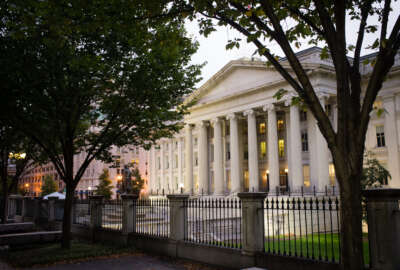
Is the G fund in trouble?
Senior Correspondent Mike Causey says the G fund becomes a political football each time Congress debates raising the debt ceiling, and that makes many investors...
The Treasury securities G fund is the most popular investment option for active and retired federal workers in the Thrift Savings Plan — except sometimes. Like now.
Many are concerned, as they have been in the past, that the government is going to borrow from the G fund until the debt ceiling issue is settled. Many fear, as they have almost every year when the issue comes up, they will somehow lose money in their otherwise super-safe investment.
The G fund has the lowest level of return (2.6 percent over the last 10 years) and 1.7 percent this year (as of September 30), but feds like it because it is “safe.” Unlike stocks and bond markets, it is guaranteed by the government. The G fund, for many investors, is the place to go in times of trouble. During the Great Recession, hundreds of thousands of investors moved from the stock-indexed C, S and I funds into the safe harbor of the G fund. Many remain there, even though the markets came roaring back. Over the last 10 years, the large-cap C fund returned 7 percent, the small-cap S fund returned 8.1 percent and the I fund returned 1.0 percent. The bond-indexed F fund had an average annual return of 4.6 percent during that period. People who bought stock funds during the Great Recession got them at bargain basement prices.
Through Sept. 30 of this year, the C fund is up 14.2 percent, the S fund is up 12.8 percent, the F fund is up 3.4 percent and the G fund is up 1.7 percent. The once-laggard international-stock I fund is up 20.3 percent. So folks who stuck with it and bought when it was down during the recession are big winners. At last.
So what about the safety of the G fund during the debt limit debate?
The Federal Retirement Thrift Investment Board (which runs the TSP) posted this notice on its website on Thursday:
“G Fund and the debt limit — (December 13, 2017): As of today, December 13, 2017, the U.S. Treasury was unable to fully invest the Government Securities Investment (G) Fund due to the statutory ceiling on the federal debt. However, G Fund investors remain fully protected and G Fund earnings are fully guaranteed by the federal government. This statutory guarantee has effectively protected G Fund investors many times over the past 25 years. G Fund account balances will continue to accrue earnings and will be updated each business day, and loans and withdrawals will be unaffected.”
Whether you should put all your eggs in the G fund, or any investment basket, is up to you. There are many reasons why everyone, especially retirees, should have stocks in their TSP retirement portfolio, as well as the G fund. But panicking over the debt ceiling issue isn’t a reason to leave the fund.
Nearly Useless Factoid
Table tennis, or ping-pong, originated in England during the 1880s, where it was played among the upper-class as an after-dinner parlour game. It has been suggested that the game was first developed by British military officers in India or South Africa who brought it back with them.
Source: Wikipedia
Copyright © 2024 Federal News Network. All rights reserved. This website is not intended for users located within the European Economic Area.
Mike Causey is senior correspondent for Federal News Network and writes his daily Federal Report column on federal employees’ pay, benefits and retirement.
Follow @mcauseyWFED





